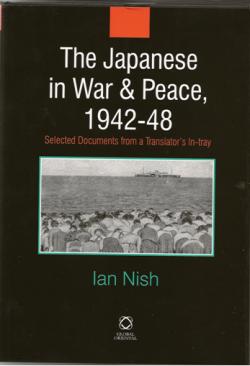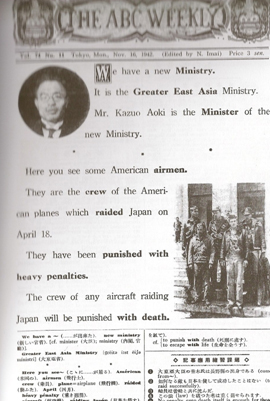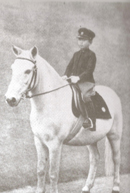The Japanese in War and Peace 1942-48, Selected Documents from a Translator’s In-tray

By Ian Nish
454 pp including index and appendices
ISBN 978-1-905246-87-8, Global Oriental, 2011
Ian Nish, Professor Emeritus in International History at LSE, spent two years with the British Commonwealth Occupation Force in Japan from 1946-48. He arrived in Kure in October 1946 as an interpreter-translator attached to the Combined Services Direct Interrogation Centre (CSDIC) with the rank of 2nd Lieutenant in the Intelligence Corps. In this book Professor Nish briefly describes his experiences in Japan. This included a stint in Matsuyama and Uwajima in Shikoku where he was very much on his own.
In the appendices he gives a selection of documents which came into his possession while he was working in Japan. He also comments on aspects of the war with Japan and the occupation. There is much fascinating material in this volume and historians interested in this period will find here many documents which shed light on Japanese war-time attitudes
It is difficult for anyone, who first experienced life in Japan after the ‘economic miracle’ had got going and seen Japan in a frenzied building boom, to grasp what Japan was like in the early years of the occupation. Japanese cities had been devastated by aerial bombardment and Tokyo seemed like a waste land. Food and other necessities were in very short supply. Means of transport were limited and jammed pack. Few roads were paved and such manufacturing industry as had survived faced demands to give up such machinery as remained for reparations to Asian countries which Japan had occupied. Former members of the Imperial Forces were being gradually repatriated although many faced long years of forced labour in Siberia where many died.
Initial fears of Japanese resistance to the occupation and of subversion were soon dissipated by the generally cooperative attitude of the Japanese people the majority of whom seemed to welcome American style democracy. The Americans who controlled military government were soon fixated on the communist threat.
Nish in his sojourn in post war Japan was able to observe the development of the new Japan. He summarises briefly the arguments which led Britain to participate in the occupation of Japan although the British Commonwealth played no role in military government. As he explains for him ‘it was a busy, and not an idle, time of doing duty in an interesting environment…It laid the foundations for my later academic career and so I look back fondly on my ‘occupation years’.
The author discusses the documents presented in the appendices under various headings. Chapter 2 deals with Japanese civilian views of the conflict. Chapter 3 deals mainly with the military view Chapter 4 is mainly concerned with the last turbulent moth of the war’. Chapters 5 and 6 cover some aspects of the occupation.
Appendix I consists of English –Language Teaching Materials The School Weekly 1940-43, which belies the accusation that Japan tried to ban the use of English during the war. Here is one page about the first American raid on Tokyo in 1942 which shows how furious and shocked the authorities were by the raid:

Appendix 2 consists of pages from Greater East Asia War Graphic (Volume II) May to December 1942. This consists largely of Japanese war propaganda, but I was struck by this photo of the present Emperor as a boy on white horse.

This section includes photographs of British prisoners of war who had been aboard the Lisbon-maru on its way to Japan when it had been sunk by an American submarine on 1 October 1942.
Appendix 3 consists of a special number of the Nippon Times Weekly dated 16 September 1943 covering ‘Science and Technique in Wartime Japan’. This demonstrates not only that at that time Japan still had a significant industrial base which had not yet suffered the devastation which was to come in 1944/5. The machinery may look antiquated today but it was state of the art in 1943. The advertisements are also worth a glance. The English used is perhaps inevitably stilted as it was not written by native English speakers.
The other appendices are much briefer. Appendix 4 provides the text of Prince Konoe’s peace memorial of 14 February 1945 which began with the words: ‘Regrettably, I think defeat is inevitable’. What a pity that other Japanese leaders were not as percipient!
The final appendix 9 records the late Professor Beasley’s ‘Personal Reminiscences of the Early Months of the occupation: Yokosuka and Tokyo’. These were dictated by Beasley to his wife in the last month of his wife and are not the same as the account which Beasley gave at a seminar in 1991 and which were included with other reminiscences of the occupation in International Studies LSE (IS91/227 of 1991)
My own experiences of the occupation have been recorded elsewhere (e,g, in my memoir Japan and Back and in the STICERD Booklet referred to above.) and I will resist the temptation to repeat some of this here. Suffice it to say that I was in Japan from June 1946 to September 1947 and served with the RAF police in the British Commonwealth Air Forces stationed at Iwakuni and Yonago where I was involved in both security and police work. I was there for a shorter time that Professor Nish and had more of an administrative role than an intelligence one.

